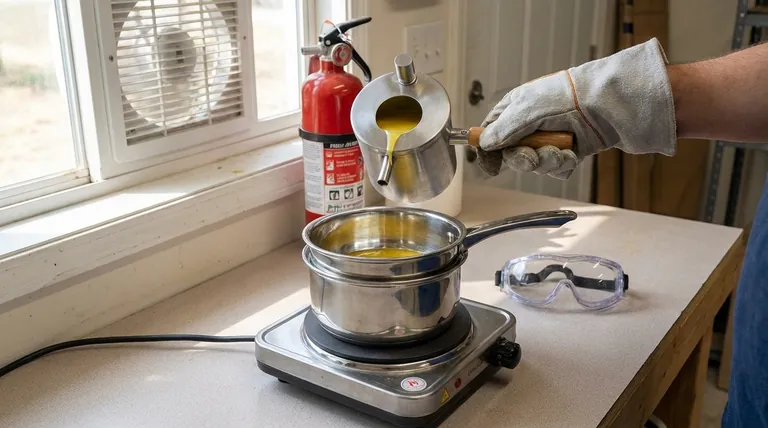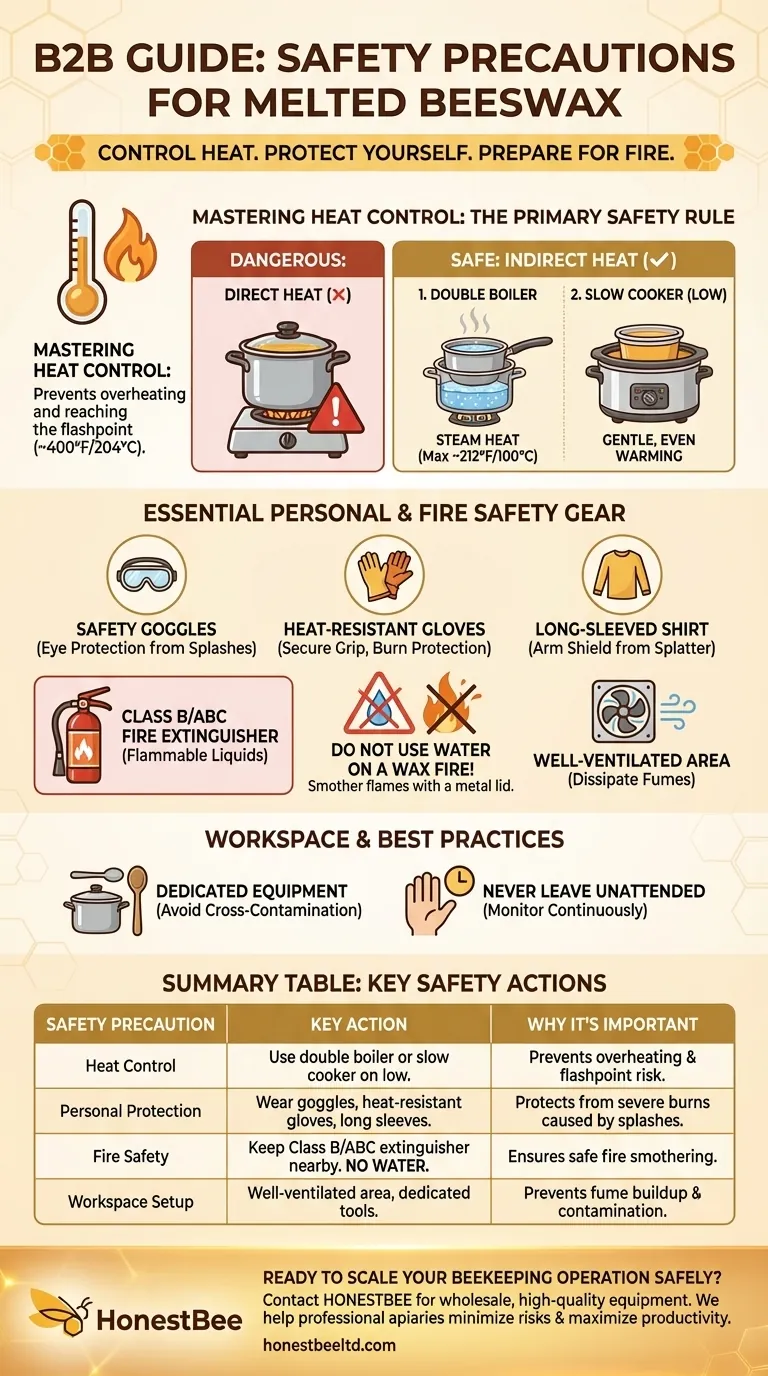The primary safety precautions for working with melted beeswax are to control the heat source, protect yourself from burns, and prepare for potential fire hazards. The most critical rule is to never use direct heat; instead, use a double boiler or a dedicated slow cooker on a low setting. Always wear protective gear, work in a well-ventilated area, and keep a fire extinguisher suitable for flammable liquids nearby.
Beeswax is a flammable material that holds significant heat, making controlled, indirect heating the cornerstone of safe handling. The biggest risks are not from the wax itself, but from improper heating methods that can lead to fire and severe burns.

Mastering Heat Control: The Primary Safety Rule
The single most important factor in safely melting beeswax is managing the temperature. Overheating the wax is what creates the most significant dangers.
Why Direct Heat is Dangerous
Beeswax has a relatively low melting point (around 145°F or 63°C), but its flashpoint—the temperature at which its vapors can ignite—is much higher, around 400°F (204°C).
Placing a pot of beeswax directly on a stove burner or open flame makes it incredibly easy to overshoot the melting point and approach the flashpoint, creating a serious fire risk.
Recommended Method: The Double Boiler
A double boiler is the gold standard for safely melting beeswax. This setup involves placing a smaller pot containing the wax inside a larger pot that holds a few inches of simmering water.
This method uses steam to transfer heat indirectly, making it impossible for the wax to get significantly hotter than the boiling point of water (212°F or 100°C), keeping it far below the flashpoint.
Using a Slow Cooker (Crock-Pot) Safely
A slow cooker set to "low" is another excellent option for indirect heating. However, you must place the beeswax in a separate, heat-safe container (like a glass Mason jar or metal can) inside the slow cooker.
Never place the wax directly into the ceramic insert of a slow cooker you also use for food, as beeswax is extremely difficult to completely remove. You can add a small amount of water to the crock-pot to help distribute heat more evenly.
Essential Personal and Fire Safety Gear
Once you have your heating method secured, the next step is to protect yourself and your workspace from accidents.
Protecting Yourself from Burns
Molten wax can cause severe burns. Always wear appropriate Personal Protective Equipment (PPE).
- Safety Goggles: Protect your eyes from unexpected splashes.
- Heat-Resistant Gloves: Provide a secure grip on hot containers and protect your hands.
- Long-Sleeved Shirt: Shields your arms from splatters.
Preparing for a Fire Emergency
Even with proper precautions, you must be prepared for a worst-case scenario.
Keep a Class B or ABC fire extinguisher within arm's reach. These are rated for flammable liquids (like oil, grease, and melted wax). Never leave melting wax unattended.
The Importance of Good Ventilation
Melting beeswax can release fumes. While not typically toxic, working in a well-ventilated area prevents the buildup of vapors and helps dissipate heat. Open a window or use an exhaust fan.
Understanding the Trade-offs and Common Pitfalls
Knowing what can go wrong is just as important as knowing the correct procedure. Avoiding these common mistakes is key to a safe experience.
The Danger of Unattended Heating
It is critical to monitor your wax continuously as it melts. The temperature can rise quickly, especially as the last solid pieces dissolve. As soon as the wax is fully liquid, remove it from the heat source.
Never Use Water on a Wax Fire
If the wax does ignite, do not use water to put it out. This will cause the flaming wax to splash and spread, making the fire much worse, similar to a grease fire. Smother the flames with a metal lid or use the proper fire extinguisher.
Cross-Contamination in Kitchen Equipment
Beeswax residue is oily and incredibly stubborn. It is best practice to use dedicated equipment for your wax projects—pots, utensils, and slow cookers that you will never use for food preparation again.
Making the Right Choice for Your Project
Your setup should be guided by your commitment to safety and the scale of your project. Have all your molds, containers, and tools prepared before you begin melting.
- If your primary focus is maximum safety: Use the double boiler method, as it provides the most reliable and gentle temperature control.
- If your primary focus is convenience for larger batches: A dedicated, large slow cooker is a viable and safe alternative, provided you monitor it carefully.
- If your primary focus is preventing mess: Thoroughly cover your entire workspace with multiple layers of parchment paper before you begin.
By respecting the properties of beeswax and preparing your workspace methodically, you ensure a safe and successful outcome for your project.
Summary Table:
| Safety Precaution | Key Action | Why It's Important |
|---|---|---|
| Heat Control | Use a double boiler or slow cooker on low. | Prevents overheating and reaching the wax's flammable flashpoint. |
| Personal Protection | Wear safety goggles, heat-resistant gloves, and long sleeves. | Protects from severe burns caused by splashes of molten wax. |
| Fire Safety | Keep a Class B/ABC fire extinguisher nearby. Never use water on a wax fire. | Ensures you can smother a fire safely if one starts. |
| Workspace Setup | Work in a well-ventilated area with dedicated, non-food equipment. | Prevents fume buildup and avoids contaminating kitchenware. |
Ready to scale your beekeeping operation safely and efficiently?
As a trusted wholesale supplier to commercial apiaries and distributors, HONESTBEE provides the high-quality, durable equipment you need to handle beeswax and other hive products with confidence. From reliable heat sources to protective gear, we help professional beekeepers like you minimize risks and maximize productivity.
Contact HONESTBEE today to discuss your wholesale supply needs and ensure your operation meets the highest safety standards.
Visual Guide

Related Products
- Professional Stainless Steel Wax Melter for Beekeeping and Crafts
- Beeswax Melter for Candle Making Honey Bee Wax Melter
- Steam Beeswax Melter Wax Warmer for Wax Processing
- Electric Beeswax Flat Sheet Machine with Operating Tray for Wax Processing
- Electric Flatting and Embossing Machine with Tray for Beekeeping
People Also Ask
- What are wax melters used for? Unlock Efficient Wax Processing for Your Business
- How can you monitor the temperature of beeswax as it melts? Ensure Quality & Safety with Precise Control
- What are the steps for using a wax melter to melt beeswax? Master Safe, Efficient Beeswax Processing
- How do you pour melted beeswax into a mold? A Step-by-Step Guide for a Flawless Finish
- What is the flash point of beeswax, and why is it important? Essential Safety Guide for Beekeepers



















